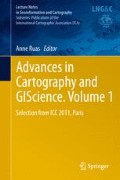Abstract
This paper presents our QGIS-MT, an extension of Quantum GIS (QGIS) for interactive tabletops. First proposed is an interactive and collaborative environment that allows several users to interact simultaneously on a multi- touch surface. This environment aims at favoring communication among users and at enhancing social awareness and the decision-making process. Next presented are the results of an interview with GIS users, which gives support to the proposed approach. In addition, presented here is a novel interaction technique, called Finger-Count Shortcuts that lets you navigate and activate numerous commands quickly and easily by performing simple finger gestures. Finally, there is a detailed discussion of how Quantum GIS was integrated into this environment and how our QGIS-MT plug-in providing multi-touch capabilities and Finger-Count Shortcuts were implemented in standard GIS menus.
Access this chapter
Tax calculation will be finalised at checkout
Purchases are for personal use only
Preview
Unable to display preview. Download preview PDF.
References
Bader T, Meissner A, Tscherney R (2008) Digital map table with Fovea-Tablett®: Smart furniture for emergency operation centers. In Frank Fiedrich, Bartel van de Walle (eds.), Proceedings of the 5th International Conference on Information Systems for Crisis Response and Management, May 2008, Washington, DC.
Bailly G, Lecolinet E, Nigay L (2008) Flower menus: a new type of marking menu with large menu breadth, within groups and efficient expert mode memorization. In ACM AVI ’08, 15-22.
Bailly G, Lecolinet E, Guiard Y (2010) Finger-count & radial-stroke shortcuts: 2 techniques for augmenting linear menus on multi-touch surfaces. In ACM CHI'10, 591–594.
Churcher N, Churcher C (1996) Group ARC - a collaborative approach to GIS. Research report (Lincoln University (Canterbury, N.Z.). Centre for Computing and Biometrics); no. 96/02
Gutwin C, Greenberg S, Roseman M (1996) Workspace Awareness in Real-Time Distributed Groupware: Framework, Widgets, and Evaluation. Proceedings of HCI on People and Computers XI, pp. 281–298
Hofstra H, Scholten H, Zlatanova S, Scotta A (2008) Multi-user tangible interfaces for effective decision-making in disaster management. In: Remote Sensing and GIS Technologies for Monitoring and Prediction of Disasters, Environmental Science and Engineering, 2008, Part 3, 243–266
Kaltenbrunner M, Bovermann T, Bencina R, Costanza E (2005) TUIO - A Protocol for Table-Top Tangible User Interfaces. In Workshop GW’05.
Kothuri R K, Ravada S, Abugov D (2002) Quadtree and R-tree indexes in oracle spatial: a comparison using GIS data. In ACM SIGMOD ’02, 546–557
Kraak M J, Ormeling F J (1996) Cartography, visualization of spatial data: Addison-Wesley-Longman, Harrow, 222
Kurtenbach G, Buxton W (1991) Issues in combining marking and direct manipulation techniques. Proc. UIST ’91, ACM Press, 137–144.
Raskin J (2000). The Human Interface: New Directions for Designing Interactive Systems. ACM Press, Addison Wesley Publishing Co.
Ryall K, Forlines C, Shen C, Morris M (2004) Exploring the effects of group size and table size on interactions with tabletop shared-display groupware. In ACM CSCW’04, pp. 284-293
Shengjun X, Yuan Y (2008) GIS Data Production Based on CSCW Supported Collaborate. In IITA ’08, vol.1, no., pp.823-827, 20–22 Dec. 2008
Vretanos P A (2005) Web Feature Service Implementation Specification. Tech. rep., OGC.
Wobbrock J O, Morris M R, Wilson A D (2009) User-defined gestures for surface computing. In CHI '09. ACM, 1083–1092.
Yeh R B, Brandt J, Boli J, Klemmer S R (2006) Interactive Gigapixel Prints: Large, Paper-Based Interfaces for Visual Context and Collaboration.In ACM Ubicomp, 06.
Diamond Touch: www.circletwelve.com
Geodan Eagle: www.geodan.com
Immersion: www.immersion.fr
Microsoft Surface: www.microsoft.com/surface
Author information
Authors and Affiliations
Corresponding author
Editor information
Editors and Affiliations
Rights and permissions
Copyright information
© 2011 Springer Berlin Heidelberg
About this chapter
Cite this chapter
A., V., G., B., Lecolinet, É., E, F. (2011). Augmenting Quantum-GIS for collaborative and interactive Tabletops. In: Ruas, A. (eds) Advances in Cartography and GIScience. Volume 1. Lecture Notes in Geoinformation and Cartography(). Springer, Berlin, Heidelberg. https://doi.org/10.1007/978-3-642-19143-5_17
Download citation
DOI: https://doi.org/10.1007/978-3-642-19143-5_17
Published:
Publisher Name: Springer, Berlin, Heidelberg
Print ISBN: 978-3-642-19142-8
Online ISBN: 978-3-642-19143-5
eBook Packages: Earth and Environmental ScienceEarth and Environmental Science (R0)

